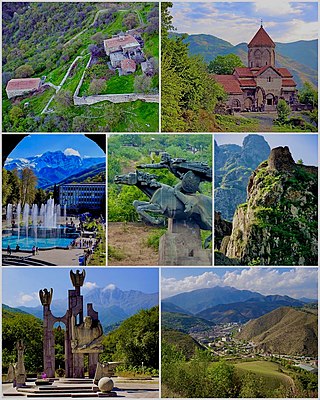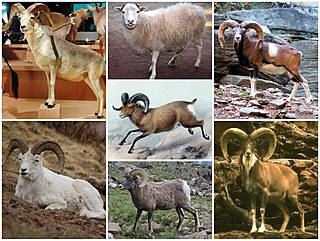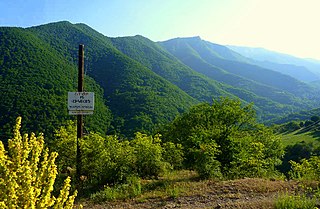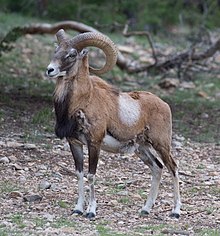
The subfamily Caprinae, also sometimes referred to as the tribe Caprini, is part of the ruminant family Bovidae, and consists of mostly medium-sized bovids. A member of this subfamily is called a caprine.

The mouflon is a wild sheep native to Cyprus, the Caspian region from eastern Turkey, Armenia, Azerbaijan, and Iran. It is thought to be the ancestor of all modern domestic sheep breeds.

The urial, also known as arkars, shapo, or shapu, is a wild sheep native to Central and South Asia. It is listed as Vulnerable on the IUCN Red List.

Kapan is a town in southeast Armenia, serving as the administrative centre of the Kapan Municipality and also as the provincial capital of Syunik Province. It is located in the valley of the Voghji River and is on the northern slopes of Mount Khustup. Kapan is the most populous town in the Syunik Province as well as the entire region of southern Armenia. According to the 2011 census, the population of Kapan was 43,190, a slight decline from 45,711 in the 2001 census. According to the 2023 official estimate, the current population of the town is around 41,300.

Capra is a genus of mammals, the goats, comprising ten species, including the markhor and several species known as ibexes. The domestic goat is a domesticated species derived from the wild goat. Evidence of goat domestication dates back more than 8,500 years.

The wild goat is a wild goat species, inhabiting forests, shrublands and rocky areas ranging from Turkey and the Caucasus in the west to Turkmenistan, Afghanistan and Pakistan in the east. It has been listed as near threatened on the IUCN Red List and is threatened by destruction and degradation of habitat.

Ovis is a genus of mammals, part of the Caprinae subfamily of the ruminant family Bovidae. Its seven highly sociable species are known as sheep or ovines. Domestic sheep are members of the genus, and are thought to be descended from the wild mouflon of central and southwest Asia.

The Caucasus mixed forests is a temperate broadleaf and mixed forests ecoregion in the Caucasus Mountains, as well as the adjacent Lesser Caucasus range and the eastern end of the Pontic Mountains.
Afghanistan has long been known for diverse wildlife. Many of the larger mammals in the country are categorized by the International Union for Conservation of Nature (IUCN) as globally threatened. These include the snow leopard, Marco Polo sheep, Siberian musk deer, markhor, urial, and the Asiatic black bear. Other species of interest are the ibex, the gray wolf, and the brown bear, striped hyenas, and numerous bird of prey species. Most of the Marco Polo sheep and ibex are being poached for food, whereas wolves, snow leopards and bears are being killed for damage prevention.

Shikahogh State Reserve is Armenia’s second largest forest reserve, covering some 10,330 ha of land, and located in southern Armenia in the Syunik Province. Environmentalists have said it has been largely unaffected by Armenia’s massive post-Soviet deforestation due to its remote location and care shown by residents of nearby villages.

Panthera pardus tulliana is a leopard subspecies native to the Iranian Plateau and surrounding areas encompassing Turkey, the Caucasus, Azerbaijan, Georgia, Armenia, Iraq, Iran, Turkmenistan, Afghanistan and possibly Pakistan. Since 2016, it has been listed as Endangered on the IUCN Red List, as the wild population is estimated at less than 1,000 mature individuals.

The wildlife of Azerbaijan consists of its flora and fauna and their natural habitats.

The European mouflon is a feral subspecies of the primitive domestic sheep. It was originally found only on the Mediterranean islands of Corsica and Sardinia, but has since been introduced into many other regions of Europe. It is not to be confused with Ovis gmelini, also called the mouflon, which is found in Western Asia and is also ancestral to modern domestic sheep.

Shvanidzor is a village in the Meghri Municipality of the Syunik Province in southeastern Armenia, near Armenia's border with Iran.

The bezoar ibex is a wild goat subspecies that is native to the montane forested areas in the Caucasus and the Zagros Mountains.
The animal name changes in Turkey is the revision of taxonomic nomenclature of three subspecies by the Turkish Ministry of Environment and Forestry. The name changes removed references to Armenia and Kurdistan in the taxonomic nomenclature of subspecies of each animal.

The Cyprus mouflon, also known as Cypriot mouflon, is an endangered subspecies of mouflon endemic only to Cyprus in the mountains of Paphos District. It is the largest animal on the island and due to its uniqueness and rarity it is the national animal of Cyprus.















